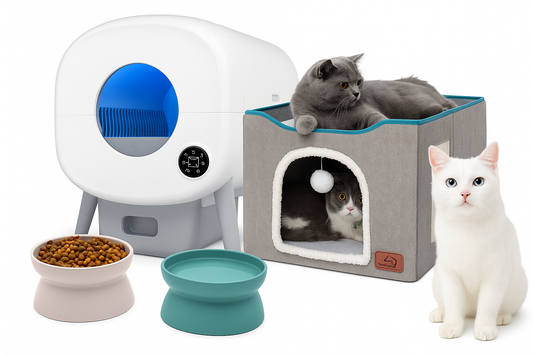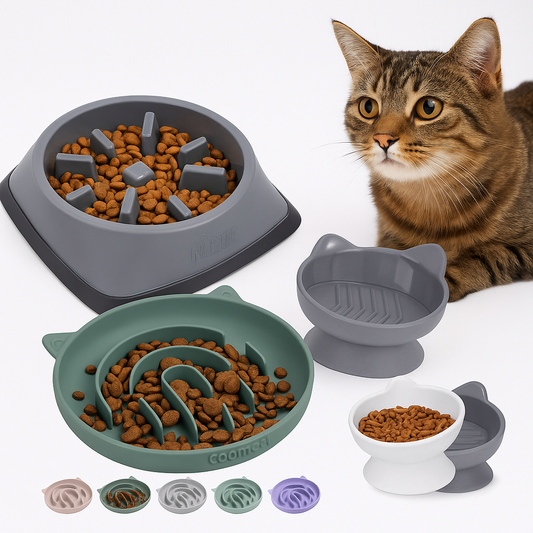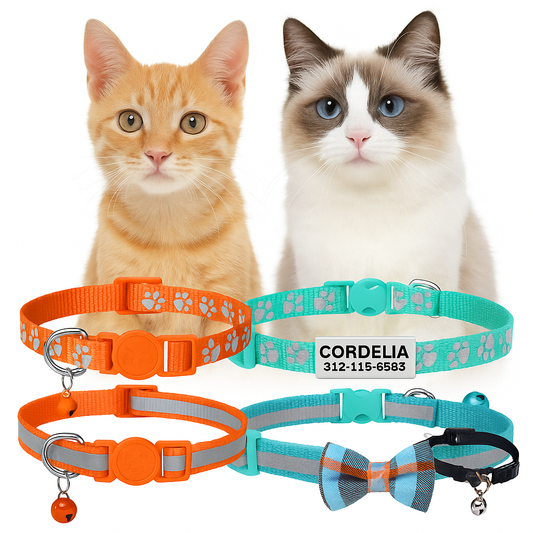
Why Your Cat Meows So Much (And What They’re Really Saying)
If you’ve ever found yourself wondering, “Why does my cat meow so much?” you’re definitely not alone. Whether it’s early morning wake-up calls, nonstop chatter during Zoom meetings, or loud protests at dinner time, excessive cat meowing can wear on your nerves.
But here’s the thing — cats aren’t just being dramatic. Unlike dogs, who bark at just about anything, cats usually meow for a reason. It’s their main way of communicating with humans, and when they’re being especially vocal, they’re likely trying to tell you something important.
So before you write it off as “just being a cat,” let’s dive into why your cat might be meowing so much — and how to understand what your cat is trying to tell you.
Why Do Cats Meow at All?
Cats don’t meow to each other once they reach adulthood — that’s a behavior reserved almost exclusively for us humans. Kittens meow to get their mother’s attention, but adult cats usually rely on scent, body language, and other subtle signals when communicating with other cats.
With humans, though? They’ve learned that meowing gets results.
So if your cat is constantly vocalizing, it’s worth paying attention. Excessive cat meowing is often your pet’s version of holding a conversation — one that can indicate needs, emotions, or even health problems.
According to VCA Animal Hospitals, "Cats will purr, yowl, growl and hiss at one another, but not meow—meowing is a behavior found only in kittens. Kittens meow for their mothers, but once mature, they still meow at us (they don’t lose the ability to meow) but not among other cats.
Reference: Why do cats meow? Decoding your feline’s secret language.
Common Reasons Cats Meow — A Lot
Let’s break down some of the most common causes behind frequent or excessive cat meowing, from the simple to the serious.
1. They’re Hungry (Or Think They Are)

This is the most obvious — and most common — reason behind cat vocalization. If your cat meows around meal times, follows you into the kitchen, or stares at their empty bowl and cries, you probably don’t need a translator. They’re hungry.
But don’t be fooled. Cats are creatures of habit and will sometimes demand food simply because they expect it, not because they actually need it.
What to look for:
- Meowing when you open the fridge or pantry
- Standing by their food bowl and yowling
- Crying early in the morning or when you get home from work
What to do:
Establish a regular feeding routine and stick to it. Avoid giving treats or snacks in response to every meow — or you’ll train them to expect food on demand.
2. They Want Your Attention
Sometimes your cat just wants to hang out. They might be lonely, bored, or craving affection. If your cat starts meowing the moment you sit down, open your laptop, or try to go to bed, they may be trying to engage you.
What to look for:
- Following you around the house
- Rubbing up against you while meowing
- Meowing when you’re busy or ignoring them
What to do:
Make time for regular play sessions and petting. Use interactive toys like feather wands or laser pointers. But don’t always reward attention-seeking meowing — reward quiet behavior too. That’s key in training them to speak less, not more.
3. They’re Bored Out of Their Minds
Indoor cats can get bored easily — and when they do, they often start vocalizing to express their frustration. This is especially common in high-energy breeds or younger cats who aren’t getting enough stimulation.
What to look for:
- Meowing with no clear reason
- Restlessness, pacing, or scratching furniture
- Increased nighttime activity and vocalization
What to do:
Enrich their environment. Try:
- Window perches or bird feeders outside the window
- Puzzle feeders and treat-dispensing toys
- Rotating toy selection weekly
- Cat trees and climbing shelves
Need ideas to get started? Here are 5 DIY cat toys you can make in under 10 minutes.
Boredom is one of the most overlooked causes of excessive cat meowing — and one of the easiest to fix.
4. They’re Anxious or Stressed
Cats are creatures of habit. Big changes — like moving, new pets, new people, or even changes in your schedule — can trigger anxiety. And when cats are anxious, they tend to vocalize more.
What to look for:
- Meowing along with hiding, hissing, or acting skittish
- Urinating outside the litter box
- Over-grooming or changes in appetite
What to do:
Identify and minimize stressors. Keep a consistent routine, introduce changes gradually, and give them safe spaces to retreat. Calming aids like pheromone diffusers (e.g., Feliway) can help. In some cases, your vet may suggest anti-anxiety medication or supplements.
5. They’re in Heat (Or Responding to a Cat Who Is)
If your unspayed female cat is suddenly meowing constantly, especially with loud, yowling cries, she could be in heat. This is hormonal behavior, and it can last for several days or more.
Unneutered males may also become more vocal if they sense a female in heat nearby.
What to do:
The best solution is to spay or neuter your cat. It not only reduces vocalization but also prevents unwanted litters and can improve overall health and behavior.
6. They’re Not Feeling Well
This is important. A sudden increase in vocalization — especially in a cat who’s usually quiet — can signal a medical issue.
Senior cats may meow more due to cognitive decline (similar to dementia), vision loss, or hearing issues. Other conditions that can cause excessive meowing include:
- Hyperthyroidism
- Kidney disease
- Urinary tract infections
- Pain or injury
What to look for:
- Changes in litter box habits
- Weight loss or appetite changes
- Lethargy or unusual aggression
- Meowing at night or for no reason
What to do:
Always rule out health issues first. If your cat’s meowing seems unusual or is accompanied by any other behavior changes, book a vet visit right away.
7. They’re Just Naturally Talkative
Some cats are simply more vocal than others — and that’s okay.
Siamese, Oriental Shorthair, Bengal, and other vocal breeds are known for being chatty. They’ll “talk” to you, to the birds outside, to their toys, and maybe even to the furniture.
What to do:
Learn your cat’s personality. If their meowing is part of a consistent, healthy routine and they seem content, it’s probably just their way of expressing themselves. You can still train them to tone it down with consistency and positive reinforcement, but embrace the conversation.
How to Understand What Your Cat Is Trying to Tell You
Meowing is only one piece of the puzzle. To really understand your cat, you need to pay attention to context and body language.
Here’s what to watch for:
| Body Language | Possible Meaning |
|---|---|
| Tail straight up, ears forward | Friendly greeting, happy to see you |
| Tail low or puffed, ears back | Fear or aggression |
| Kneading with paws | Comfort, affection |
| Purring + meowing | Excited or content (or possibly in pain — depends on context) |
| Wide eyes + meow | Alert or demanding attention |
| Repeated meowing + pacing | Restlessness, stress, or need |
Combine these signals with the tone, pitch, and frequency of their meows. A short, chirpy meow can mean “Hi!” while a loud, drawn-out yowl may signal frustration, pain, or demand.
Training Tips to Curb Excessive Cat Meowing
If your cat’s meowing has become disruptive, here’s how to address it without punishing them:
- Don’t yell or scold. It rarely works and can damage trust.
- Ignore attention-seeking meows. Reward quiet behavior instead.
- Feed on a schedule. Avoid free-feeding or feeding on demand.
- Provide enrichment. Toys, scratching posts, climbing trees, and interactive games go a long way.
- Be consistent. Don’t give in one day and scold the next. Mixed signals confuse cats.
- Visit the vet. Always rule out medical issues first.
Training a cat isn’t about dominance — it’s about building a predictable routine and reinforcing calm, quiet behavior.
When to Worry About Excessive Meowing
You know your cat best. If their behavior suddenly changes or something feels off, don’t ignore it.
🚩 Red flags include:
- New, excessive vocalization in a usually quiet cat
- Meowing with physical symptoms (vomiting, limping, hiding)
- Nighttime crying in senior cats
- Meowing while using the litter box
- Meowing with signs of disorientation or confusion
Trust your gut. If it seems like more than “just talking,” get them checked out.
For more signs your cat might not be feeling well, check out this guide to common cat health issues.
Final Thoughts
So, why does my cat meow so much? It could be hunger, boredom, stress, illness — or they might just be chatty. But the key is this: they’re not doing it for nothing.
Cats meow because they’re trying to communicate. When you start listening — not just hearing, but really understanding — you can respond in a way that improves both of your lives.
Decoding cat communication takes time, but it pays off. You’ll strengthen your bond, reduce their stress (and yours), and maybe even enjoy the chatter a little more.
Just don’t forget: they’re talking to you because they trust you. Even if what they’re saying is, “Feed me for the third time today.”
Need help figuring out your cat’s behavior? Drop your questions below or share your story — we’d love to hear what your cat has to say.



